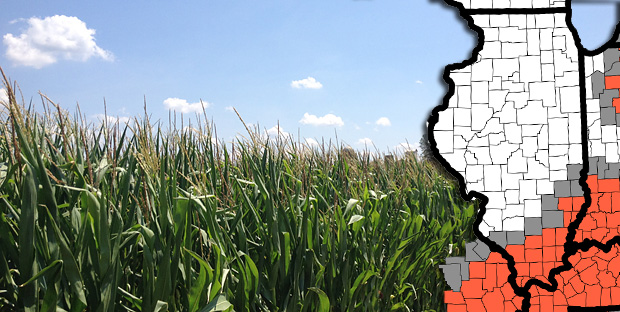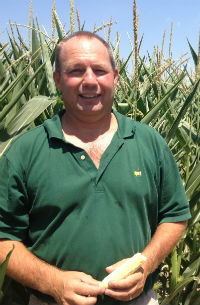It’s not exactly paydirt, but good soil makes a big difference in a drought
By Niala Boodhoo

It’s not exactly paydirt, but good soil makes a big difference in a drought
By Niala Boodhoo
If you think it’s been hot in the city - with all that heat reflecting off the pavement - it’s actually not that much cooler in the country. On Steve Ruh’s farm, about fifty miles west of Chicago in Kane County, a warm breeze is rustling the tall, green corn stalks. But the sun’s still beating down, and the plant’s leaves have shriveled up to protect itself. It’s hard for Ruh to watch.
“Lately by 2 o’clock in the afternoon, I’m usually looking for, uh, a place to go hide when the corn is suffering,” he admitted.
This shrunken corn is definitely not as pretty as Ruh would like it to be. But, it’s still growing - and producing kernels.
He ripped open a plant to show me a pale, yellow cob. Then he counted the kernels - that’s how farmers measure growth.
This particular ear had 16 rows. Ruh was surprised, because most of the corn he’s checked in other fields are much smaller. He’s expecting a yield that is 25 to 30 percent less than last year.
But still, he’s in much better shape than the lower half of the state. The reason has to do with the ground he’s standing on — as it turns out, it helps to have good dirt.
A few hundred miles south, on Jim Anderson’s 750-acre farm in Williamson County, the dirt is working against him. He describes his dirt as so dry, “it’s like concrete powder”.
“It is very, very hard and you can’t find any moisture,” he said.
The best ear he could find had 72 kernels on it — for an entire ear of corn. This one didn’t even grow enough to create full rows. And it’s not really yellow. It’s grey.
Anderson said that’s what happens to his corn when it dries out.
“It looks like you have put a powder on it,” he said, adding it started when the corn was about a knee high. “It has twisted and been a grey color ever since.”
The main difference between Kane and Williamson County – and Steve Ruh’s and Jim Anderson’s farms - isn’t just a few hundred miles. Nor is it the amount of rain received this year, although Kane County has had at least a tiny bit more rain. It’s literally the ground the crops are planted in.
Illinois farmers like to boast their soil is the best in the world. But it depends on where you are in the state.
“When we talk about the best soil in the world, we’re talking about that soil in the northern two-third of Illinois,” clarifies John Hawkins, of the Illinois Farm Bureau.
Geologist Andrew Stumpf said this is all because of glaciers - from Ice Ages that occurred 600,000; 200,000; and 15,000 years ago.
“When the glaciers came across, they deposited glacial till — sand, silt, clay, gravel,” said Stumpf, who works with the Illinois State Geological Survey. “Soil develops in that material. it gets broken down and there is organic material mixed in. So, the soil is really a derivative of what material was there from the glacier.”

Unfortunately for farmers in the south, the glaciers went only as far as what is today I-70.
South of that, the other soils tend to be less fertile because of the clay, Stumpf said, adding those soils are sandier and can’t hold as much water.
For Anderson, farming in that sandier dirt, this year, means his corn crop could be a total loss for his corn crop.
“Truthfully I do not even know if I will pull a combine into the field this year or not,” he said, adding he is expecting instead to file crop insurance claims.
Anderson is 65. He took over this farm from his father. He said despite the drought, he’ll plant again next year.
“If you are going to be easily discouraged, or if you are not an optimistic person, you cannot farm,” he said.
Ruh, on the other hand, still has hope for this year. It comes partially from his father, whose farm he also took over.
His father looks out the window and says his fields still look better than the droughts of 1988 and 1954.
“The script is not complete yet,” he said.
That’s why he doesn’t think you should count out his corn just yet. Thanks to the dirt, it’s still got a fighting chance.
